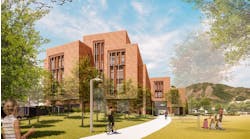For several years, education institutions have been in the vanguard of designing and constructing facilities that consume less energy and resources than schools of earlier generations.
Groups such as the U.S. Green Building Council and the Collaborative for High Performance Schools have helped educate and motivate schools and universities to pay close attention to how their buildings can conserve resources and operate more efficiently.
Sustainable school design has become a common element in education facilities—many jurisdictions mandate that school construction projects achieve specific levels of LEED certification or other measure of green practices.
But some designers are not satisfied with the level of green design they have achieved. They are striving to create learning spaces that have less impact on the environment and use resources with greater efficiency.
The result is a facility like the Stevens Library at the Sacred Heart Lower and Middle School in Atherton, Calif. The $2.4 million, 6,300-square-foot space, which opened in December 2012, was certified in 2014 as the first school building in California to achieve Net Zero Energy Building Certification from the International Living Future Institute.
WRNS Studio, which designed the library, says energy usage in the building for its first year was measured at 24,394 kilowatt hours; over that same year, the library generated 56,811 kilowatt hours.
The sustainable strategies in place in the facility include a photovoltaic system that provides all the library’s needed energy, solar tubes to maximize daylighting inside the building, daylight monitoring systems and lighting occupancy sensors to minimize electricity usage, a high-efficiency mechanical system, low-flow water fixtures, a high-performance envelope that uses continuous rigid exterior insulation, building shading systems, and a rainwater collection system for campus irrigation.
Pauline Souza, WRNS director of sustainability and the project manager for the library, says construction of the library and its track record of energy efficiency since it opened are clear evidence that ambitious energy-saving projects can be successful.
“We think the Stevens Library shows how a project can be done within the set budget,” says Souza. “Also, we have found because it has a dynamic plaque that shows the trends of daily, monthly, and yearly use…users are more aware of how to use the project.
“Educating folks that you can have a comfortable and inspiring space while saving resources is the most important evidence. And engaging students and our next generation so that they are more aware of what we are facing and how we can start to solve things is the ultimate goal.”


